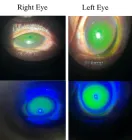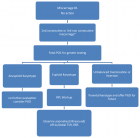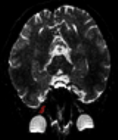Table of Contents
Nebulization as complementary therapy for dogs with respiratory tract infections
Published on: 4th October, 2019
OCLC Number/Unique Identifier: 8299739396
Respiratory tract infections in dogs pose a significant problem and often require prolonged treatment. The effectiveness of pharmacological therapy can be improved through the administration of nebulized compounds to liquidize mucus and promote its evacuation from the respiratory tract. The aim of this study was to evaluate the effectiveness of nebulized 0.9% NaCl in dogs with respiratory tract infections. Respiratory functions were assessed based on the results of arterial blood gas analyses, and the patients’ clinical status was determined by evaluating the severity of symptoms on a point grading scale. Inhalation of nebulized 0.9% NaCl significantly accelerated improvement in the patents’ clinical status (normalization of body temperature, decreased cough frequency, decrease/elimination of nasal and ocular discharge, improved appetite) and improved pulmonary gas exchange by reducing partial pressure and total content of carbon dioxide and increasing partial pressure and total content of oxygen in blood.
Prevalence and seasonal variations of eggs of gastrointestinal nematode parasites of goats from smallholder farms in Mozambique
Published on: 23rd July, 2019
OCLC Number/Unique Identifier: 8206561393
A survey was carried out to determine the prevalence and seasonal variations of eggs of gastrointestinal nematodes in goats in four provinces of Mozambique, from November 2016 to October 2017 in Tete and Cabo Delgado, and from November 2016 to October 2018 in Maputo and Gaza. In each province, flocks were selected from both lowlands, located within the valleys of the rivers, and uplands which are located outside the valleys. Faecal samples were collected at monthly intervals to monitor faecal egg counts fluctuations. The modified McMaster technique was used for quantitative analysis of nematode eggs and for detecting cestode eggs in faecal samples. The sedimentation technique for detecting trematode eggs in faecal samples was used. A total of 2 703 samples were examined for nematode eggs and 2 587 for trematode eggs. Faecal examination indicated that between 18% and 100% of goats sampled were infected with gastro-intestinal nematodes. The prevalence varied according to the season of the year and the ecological conditions. The highest prevalence and worm egg counts were recorded at about the peak of the rainy season. Strongyloides papillosus, Calicophoron spp., Fasciola spp. and Schistosoma mattheei eggs were also found. Moniezia expansa and Moniezia benedeni eggs were found in all the four study areas but its prevalence was low and irregular. Based on the results of this study, which showed a clear seasonal pattern, strategic anthelmintic medications to effectively control helminth infections in goats in the different ecological zones of Mozambique are suggested.
An analysis of wild animals with respect to French Ethics and Law
Published on: 9th May, 2019
OCLC Number/Unique Identifier: 8163878958
Before discussing the crux of the matter, it is important to understand what “wild” signifies and the characteristics that define a wild animal.
As contrasted to domesticated animals, a wild animal can be defined as an animal living freely in his natural habitat, independently of Man. These animals are only exposed to variations in the biological equilibrium, to the imperatives of their genetic program and live in a habitat that gives them the possibility of expressing it themselves.
However, this definition is very narrow as there exist a number of species of wild animals that don’t live freely in their natural habitat. These animals are constrained by Man, who by creating a relationship of dependence, controls them and in turn becomes responsible for their sustenance. In such a situation, their habitat is no more their natural habitat but than which has been imposed on them by Man; such animals are said to be “held in captivity” or even “tamed”.
In short, when talking about law and ethics related to wild animals, there are two things to be taken into account: wild animals that live in the wild and wild animals that live held in captivity by Man.
Use of the Reverse Transcription-Polymerase Chain Reaction for differential detection of two lineages of the canine distemper virus in Chile
Published on: 4th March, 2019
OCLC Number/Unique Identifier: 8056345040
Worldwide, Canine Distemper Virus (CDV) infection is a highly prevalent disease with high morbidity and mortality. CDV causes a multisystemic disease in a wide range of hosts including 9 families of mammals among them some primates, cetaceans and numerous carnivores. It presents a high tropism for lymphoid, neurological and epithelial tissue, leading to an infection of almost all systems, so the clinical signs observed are very varied. The diagnosis is made based on the clinical presentation of the disease, which considers a variety of signs and must be confirmed by a laboratory diagnostic method. The molecular technique called Reverse Transcription Polymerase Chain Reaction (RT-PCR) has been used to characterize viral strains based on the basis of genetic differences on the hemagglutinin (H) gene of CDV has allowed the identification of 14 circulating lineages in the world. Two lineages, namely the America-1 and the Europe-1/South America-1 have been described in Chile. The goal of this work was to implement a multiplex RT-PCR protocol, which was built on the in silico design of primers based on the H gene nucleotide sequences stored in the Genbank® database. This method was capable of detecting the previously described two circulating genetic lineages of CDV in a differential way providing a supporting diagnostic tool for epidemiological studies in the country. These results suggest that the primers described here are extremely selective for the above-mentioned lineages. In addition, our initial screening indicated that most analyzed clinical samples corresponded to the America-1 lineage, stressing the need for a continuous surveillance in order to properly address the prevalence of both lineages in Chile.
Zoonotic potential of Giardia lamblia and control of giardiasis
Published on: 7th February, 2019
OCLC Number/Unique Identifier: 8005444774
Giardia is the most common pathogenic intestinal flagellate protozoan in the world. The most studied species is Giardia lamblia (syn. Giardia intestinalis, Giardia duodenalis) that infects mammals, including humans. About the other seven species the scientific literature is very scarce and little is known about its characteristics and epidemiological importance. The exception is Giardia muris species that is frequently used in experimental infection to attempt to understand the parasite-host interaction in G. lamblia infection [1].

If you are already a member of our network and need to keep track of any developments regarding a question you have already submitted, click "take me to my Query."


















































































































































